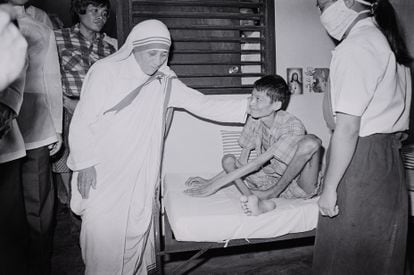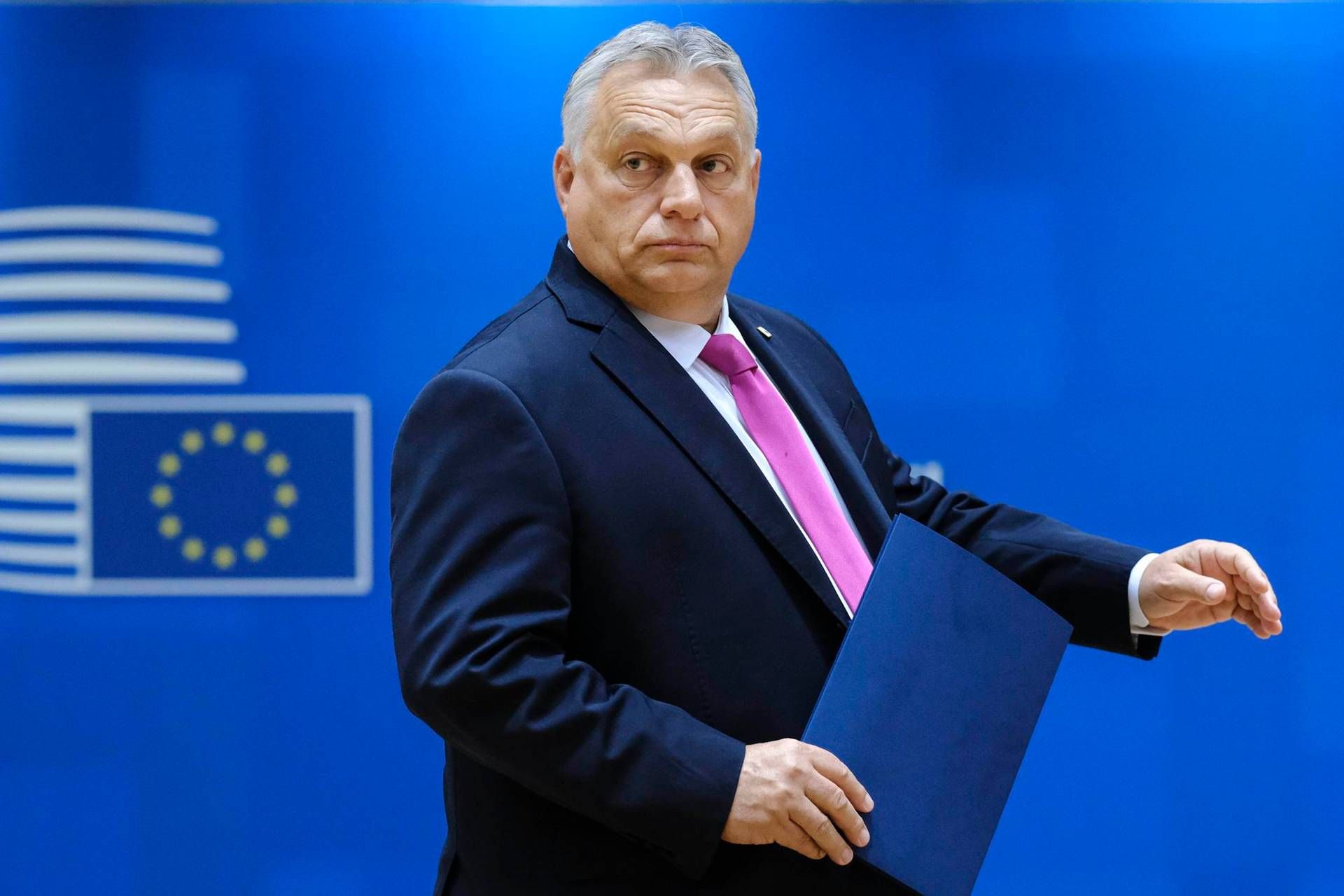A BBC documentary in 1969 catapulted Mother Teresa to world fame. And in 1994 another of hers, from Channel 4, projected on her the shadows that would never be removed from her, despite her canonization in 2016, 19 years after her death. First, Something Beautiful for God (A Beautiful Thing for God), was an overtly hagiographic project by Malcolm Muggeridge in which the writer interviewed the nun and publicized her work with the poor in Calcutta, where she had opened a home for the dying, an orphanage, and a colony for lepers. The second, Hell’s Angel (The Angel of Hell), was a frontal attack in the form of a pamphlet promoted by three of her fiercest critics, Aroup Chatterjee, a doctor who had worked with the poor in Calcutta and who since the 1980s had questioned the nun’s methods, and journalists and essayists Tariq Ali and Christopher Hitchens. Now the docuseries Mother Teresa: for the love of God?, which can be seen in Spain on SkyShowtime a year after its premiere on the British channel Sky —one of the partners that make up the new platform—, offers a starkly complex overview of the Albanian nun who ended up becoming an icon of Christian charity , a world reference and also the most effective and influential propaganda and collection machine that the Catholic Church had during the papacy of John Paul II. The production acknowledges her achievements but also highlights her dark side. And it aggravates one of her charges against her, by suggesting that she not only protected a pedophile when the Church began to suspect him, as published in 2019, but that she was aware or at least suspected of the existence of the abuses. .
Mother Teresa: for the love of God? start at the end. For the death of Agnés Gonxha Bojaxhiu on September 5, 1997. And recovers some testimonies from individuals collected by television at the time to reflect the shock which caused the death of millions of people. “If Diana was the queen of hearts, Mother Teresa was the queen of the poor and of humanity,” says one man. The comparison is not free, and not only because Diana of Wales had died five days before: Teresa of Calcutta’s story, like that of Lady Di, was sold as “a fairy tale come true”, in the words of Chatterjee. The strategy followed by those responsible for the documentary, directed by Ziyaad Desai and Benedict Sanderson, is to remember precisely that fairy tales are just that, stories. They do, yes, offering a varied chorus of voices for and against.
Muggeridge and Hitchens, now deceased, appear only in archive footage. But along with Chatterjee and Tariq Ali, the director of that BBC program with which the cult of the founder of the Missionaries of Charity began, Peter Chafer, is also summoned, who explains the impact that visiting the centers in Calcutta caused him. in which they cared for the poor, orphans and the sick. “It was unbearable for me to live that for a single day, and there we had that nun who took charge of what most would avoid, which occupied all the hours and minutes of her life,” he explains. The documentary acknowledges the dedication of the Calcutta saint, but confronts Chafer’s testimony with that of a doctor who went to the Bengali capital in the 1970s to work side by side with the congregation and who ended up disengaging and setting up his own clinic for the refusal of the missionaries to provide due medical attention to the sick.
Friends, followers and apologists for Mother Teresa parade through the miniseries, including one who affirms that when he finally met the nun in person his schizophrenia was cured, something that those responsible for the documentary do not bother to question. But to her testimonials, in line with the official and majority version that emphasizes her goodness, those of her critics are opposed. Thus, it stands out that in a decade as marked by materialism as the eighties, she was “countercultural”, in the words of the president of the US Catholic League, Bill Donohue, because she represented the antithesis of greed and consumerism. And Chatterjee counters that she, too, represented an old colonial vision: “The idea of a white savior saving people of color was very attractive to the West.” It is remembered, for example, that in 1985, after visiting the Sing Sing prison and meeting several AIDS patients, she opened a center in New York to care for them. But she also abounds in her furious crusade against abortion, which in her acceptance speech upon receiving the Nobel Peace Prize she defined as “the greatest destroyer of peace”, and against contraceptive methods. .

Over the course of three hours, most of the reproaches that have been leveled at its protagonist since the 1990s are recounted: his religious fundamentalism, according to which being close to those who suffer and sharing their suffering allows us to get closer to that of Christ on the cross ; his preference for prayer over painkillers to soothe the pain of the sick; its refusal to provide its hundreds of centers around the world with medicines and medical supplies, and to launch programs to combat poverty in Calcutta, despite the hundreds of millions of dollars it receives annually in donations, most of which end up in the Vatican bank; the opacity of his accounts; his attachment to the powerful and his double standards with them, including satraps such as the Duvaliers, or his intercession by letter asking the judge to be benevolent when passing sentence against the fraudster Charles Keating, responsible for the biggest known financial fraud until then, an episode to which the documentary adds the testimony of the prosecutor in the case, who says that he in turn wrote a letter to the nun asking her to return the hundreds of thousands of dollars that Keating had donated to his congregation because it was money stolen from the poor , and never received a response.
Other especially juicy testimonies enrich the documentary. An adult raised in the Calcutta hospice stresses that he will always be grateful to Mother Teresa, but clarifies that the conditions and treatment at the center were not good and that she “could be brutal” with other nuns. And Mary Johnson, who was a close collaborator of the saint and left the congregation shortly before her death, recounts that the nuns could not have friends, that they could only visit the family for two weeks every 10 years and that the physical self-punishment, with cilices and knotted ropes called “discipline” with which the sisters flogged themselves. “Many of the things that the Missionaries of Charity demanded of their members are very similar to what the sects demand,” she settles.
The series also incorporates a much more recent charge: the protection and even the possible cover-up of a pedophile, the Jesuit priest Don McGuire, who for years was a confidant of Mother Teresa and traveled the world working and raising funds for the congregation, always accompanied by minors whom he systematically abused. McGuire was convicted in 2009, but 15 years earlier, when suspicions towards him were already mounting within the Church, the Jesuits ordered him to undergo a psychiatric evaluation, which determined that he had a sexual disorder and a paranoid and narcissistic personality. and enter a center for treatment. But a letter signed by Mother Teresa in defense of the accused changed things and McGuire was able to continue practicing, and abusing minors, for almost a decade.
This is the only criticism that the Missionaries of Charity respond to in the miniseries. The first two chapters close with a statement saying that they will not be distracted from their work to refute the “posthumous insults” that defame its founder. The latter, on the other hand, includes a message in which they allege, as they did when the press aired the McGuire affair in 2019, that Mother Teresa was not the author of the letter in her defense, that they gave it to her to sign, that she agreed because a senior Jesuit official guaranteed her innocence and that she had no proof of the abuses. However, according to the lawyer of 12 of the victims, one of them assures that Teresa of Calcutta herself came to ask him on one occasion if McGuire did bad things to her. According to this version, the boy replied that he did not want to talk about it, and that same night the priest abused him again.
You can follow EL PAÍS TELEVISIÓN on Twitter or sign up here to receive our weekly newsletter.
Receive the television newsletter
All the news from channels and platforms, with interviews, news and analysis, as well as recommendations and criticism from our journalists
SIGN UP
#Face #crosses #Mother #Teresa #Calcutta









